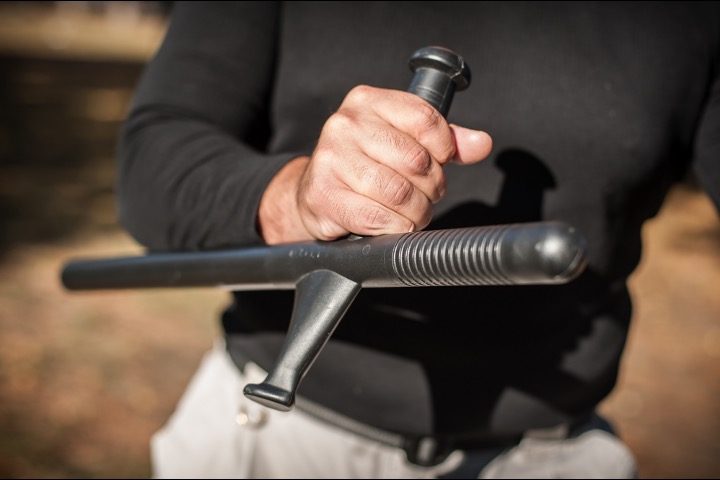
The ruling from the Southern District Court of California on Friday further clarified the Second Amendment’s use of the word “arms,” saying it includes billy clubs, also known as batons, truncheons, nightsticks, or billysticks.
In Fouts v. Bonta, Judge Roger Benitez (appointed by President George W. Bush in 2003) ruled that “Americans have an individual right to keep and bear arms, whether firearms or less lethal arms,” noting that:
Some people have made the personal decision to not keep and carry a deadly firearm for self-defense. Instead, they sometimes wish to keep or carry a less lethal arm for self-defense.
But politicians in California, in their zeal to reduce the right to keep and bear arms down to absolute zero, passed a law prohibiting not only the public carrying of a billy club, but also its mere possession:
Any person in this state who manufactures or causes to be manufactured, imports into the state, keeps for sale, or offers or exposes for sale, or who gives, lends, or possesses any leaded cane, or any instrument or weapon of the kind commonly known as a billy, blackjack, sandbag, sandclub, sap, or slungshot, is punishable by imprisonment in a county jail not exceeding one year….
Benitez posed this metaphor illustrating how unjust the law is:
A young girl is walking home from school one evening. She is walking through a part of town where robberies, assaults, and rapes have occurred; where youth gangs are known to frequent; and where unrestrained dogs are known to roam.
The young girl is wearing a baggy, oversized sweatshirt sometimes associated with gang affiliation. In her hand, she is holding a billy—a baton just like the ones law enforcement officers often carry for their protection.
An officer sees her walking and sees that she is in possession of the baton. The officer arrests her for violating California Penal Code § 22210. She is handcuffed, placed in the back of a police car, transported to the police station, booked, fingerprinted, and initiated into the juvenile court system.
Although there is no evidence that she has ever struck or threatened to strike anyone with the baton or that she is in danger of hurting herself with it, her mere possession of it is enough.
That she was in possession of the billy to protect herself in self-defense from human or animal predators is not determinate. It is irrelevant.
And why does California elect to make this girl a criminal? Because there is a risk, no matter how small, that the girl might use it for an unlawful purpose, or that others may use similar weapons for unlawful purposes.
The United States Constitution prohibits such intrusions into an otherwise law-abiding citizen’s choice for self-defense.
Judge Benitez then expanded the definition of “arms” in the Second Amendment by citing Caetano v. Massachusetts (2016), in which the Supreme Court ruled that Massachusetts “erred in upholding a law that prohibited the possession of stun guns.” And that ruling relied on prior Supreme Court decisions, District of Columbia v. Heller (Heller) and McDonald v. City of Chicago (McDonald), declaring that “the Second Amendment extends … to all instruments that constitute bearable arms, even those that were not in existence at the time of the founding.”
In his ruling, Judge Benitez wrote that “the American tradition is rich and deep in protecting a citizen’s enduring right to keep and bear common arms, whether they be rifles, shotguns, pistols, knives, or less lethal weapons like stun guns and billies.”
Attorneys for the State of California tried to argue that since its “billy” law had been in existence since 1923, it withstands the Bruen command that it show historical relevance. Judge Benitez didn’t buy it:
What is different today is that a statute enacted in 1923 is no longer given a pass for being “longstanding.” Important for this case, it is clear now that the critical time period is not the early twentieth century.
The most important period is the years following the adoption of the Second Amendment (1791), and of lesser importance, the years around the adoption of the Fourteenth Amendment (1868).
For this case, changing the relevant time period changes the outcome.
And this command from Bruen ended, for all intents and purposes, California’s defense:
Today, the government [the State of California] is short on evidence: evidence that billies are not commonly possessed by law-abiding citizens for lawful purposes, and, evidence of a historical tradition of prohibiting possession of a billy as a crime.
Attorneys for the state refused to give up. They presented to the court a list of 250 laws that they said were relevant to, and persuasive in, supporting its case. Judge Benitez reviewed them and curtly dismissed them as irrelevant: “The State has had lots of opportunities to discover, identify, and highlight historical laws prohibiting the possession of a billy. There is little.”
He added:
Having reviewed each of the 250 laws listed by Defendant, it is quite clear that there is no national historical tradition of prohibiting the simple possession, or the open carrying, of a billy evident during the important period of history when lawmakers still had an unmolested conception of the original meaning of the Second Amendment.
In fact, wrote Benitez, “During the time the Founders were alive, and all the way up to the end of the Civil War in 1865, there were no state restrictions in any of the states or territories on possessing or carrying a billy. This is the most persuasive evidence that the original understanding of the Second Amendment protects a person’s right to keep and carry a billy.”
He concluded:
The Second Amendment protects a citizen’s right to defend one’s self with dangerous and lethal firearms.
But not everybody wants to carry a firearm for self-defense. Some prefer less-lethal weapons. A billy is a less-lethal weapon that may be used for self-defense.
It is a simple weapon that most anybody between the ages of eight and eighty can fashion from a wooden stick, or a clothes pole, or a dowel rod.
One can easily imagine countless citizens carrying these weapons on daily walks and hikes to defend themselves against attacks by humans or animals.
To give full life to the core right of self-defense, every law-abiding responsible individual citizen has a constitutionally protected right to keep and bear arms like the billy for lawful purposes.
And not only billy clubs, either, as noted above. In a unanimous ruling by the Ninth Circuit Court of Appeals last summer, Hawaii’s ban on possessing so-called butterfly knives — knives whose handles fold upward around the blade — was tossed, and for the same reason: Bruen’s demand that there be an historical reference or analogy to defend such infringements.
Again, the defendants in this case — Teter v. Lopez — lost thanks to Bruen:
Because the possession of butterfly knives is conduct protected by the plain text of the Second Amendment, and because Hawaii has not demonstrated that its ban on butterfly knives is consistent with this Nation’s historical tradition of regulating arms, we conclude that section 134-53(a) violates Plaintiffs’ Second Amendment rights….
Hawaii cited no analogues in which Congress, or any state legislature, imposed an outright ban on the possession of pocketknives close in time to the Second Amendment’s adoption in 1791, or the Fourteenth Amendment’s adoption in 1868.
Thanks to the Supreme Court’s ruling in Bruen, efforts of Marxists infiltrating the far Left to disarm (and then enslave) the American people have become increasingly difficult.



